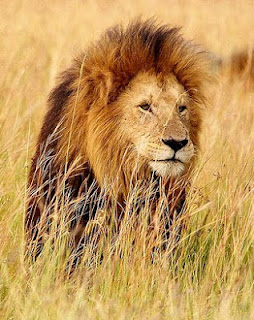Lions from western and central Africa are believed to be smaller than lions from southern Africa. It is also suggested, that they have smaller manes, live in smaller groups, and they may also differ in the shape of their skull. In the Pendjari National Park area, which is within the range of the West African lion, almost all males are maneless or have very weak mane
Leones de África occidental y central se cree que son más pequeños que los leones de África meridional. También se sugiere, que tienen crines más pequeños, viven en grupos más pequeños, y también puede diferir en la forma de su cráneo. En el área de Pendjari National Park, que está dentro del alcance de la mayor parte de África Occidental, casi todos los hombres son maneless o tienen muy débil melena
A recent study further established the exclusivity of the West African lion and showed, that lions from central and western Africa (including eastern Sahel) vary genetically from lions of southern or eastern Africa. According to the study, West African lions are even more directly related to Asian lions, than to South or East African ones. These conclusions might be explained by a late Pleistocene extinction event of lions in western and central Africa about 20.000 years ago and a later recolonisation of these parts, coming from Asia.
Un reciente estudio estableció además la exclusividad de la mayor parte de África Occidental y mostró, que los leones de África central y occidental (incluyendo este de Sahel) varían genéticamente de los leones del sur o el este de África. Según el estudio, los leones de África Occidental son aún más directamente relacionados con los leones asiáticos, que a los del Sur o del Este de África. Estas conclusiones podrían explicarse por un evento Pleistoceno tardío extinción de los leones en el oeste y centro de África hace aproximadamente 20,000 años y una recolonización posterior de estas piezas, procedentes de Asia.
West African lion is found in western Africa, south of Sahara from Senegal in the west to the Central African Republic in the east. Another subspecies (P.l. azandica) is traditionally described from north-eastern DRK (Democratic Republic of Congo), a country located in Central Africa. It is the second largest nation in Africa by area and the eleventh largest in the world. Lions are uncommon in western Africa and may be critically endangered in this region. They are comparatively rare in captivity as well. In the year 2006 there were just 13 specimen, which are registered under the name P. l. senegalensis.
West león africano se encuentra en el oeste de África, al sur del Sahara, desde Senegal en el oeste de la República Centroafricana en el este. Otra subespecie (Pl azandica) se describe tradicionalmente desde el noreste de DRK (República Democrática del Congo), un país situado en África Central. Es el segundo país más grande de África por área, y la undécima más grande del mundo. Los leones son poco comunes en el África occidental y pueda estar en peligro crítico en esta región. Son relativamente raro en cautiverio también. En el año 2006 sólo había 13 muestras, que se registró con el nombre de P. l. senegalensis.
According to an estimate there are possibly only 450-1,300 lions left in West Africa. In addition, there are approximately 550-1,550 animals in Central Africa. In both the regions, the area populated by lions has been reduced to less than 15 per cent of the historic range.
Según una estimación, hay posiblemente sólo 450-1,300 leones que quedan en África occidental. Además, hay aproximadamente 550-1,550 animales en África Central. En ambas regiones, la zona poblada por leones se ha reducido a menos del 15 por ciento del área de distribución histórica.



No hay comentarios:
Publicar un comentario